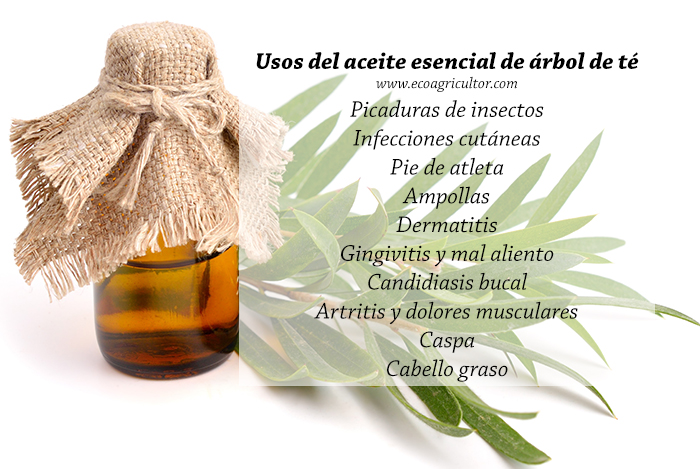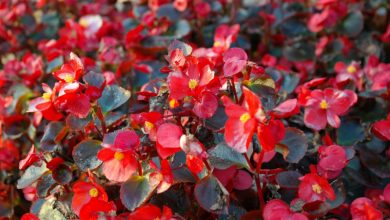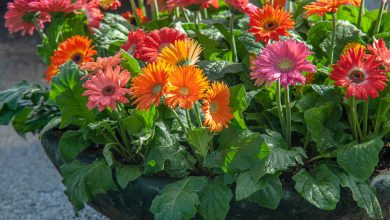35 uses of tea tree essential oil

There are numerous plants that are used for their different medicinal properties and the tea tree is one of them. In the oil tea tree they are attributed countless benefits to our health and beauty. Do you want to discover them and take advantage of them too?
In this article we tell you all about tea tree essential oil: What it is, its active principles, 35 uses of tea tree essential oil, what to consider when buying tea essential oil, how to use it and the contraindications of tea tree essential oil.
What is tea tree oil?
Known by its scientific name Melaleuca alternifolia , this small plant with white flowers with great aroma and narrow leaves originated in Australia and for many years has been used for its many benefits, both on the skin and on the hair and is even used in folk medicine against some diseases. The use of tea essential oil is very common today in practically every corner of the world.
What is tea tree oil?
Tea tree oil is obtained from the distillation of the fresh leaves and branches of this tree. It is made up of more than 100 compounds, mainly monoterpenes, sesquiterpenes and their alcohols. Among them, the main active principles are terpineol (35%) and cineol (4%), which are responsible for this antiseptic action for which this essential oil is known.
Read also Properties of Eucalyptus essential oil
..
35 uses of tea tree essential oil, Melaleuca alternifolia
Tea tree oil, as mentioned above, has several uses and here I show you some of them:
1.- Disinfection of wounds and burns : The pure oil is applied directly to the injury
2.- Acne : Apply 3 drops directly to the infected area or 20 drops in a facial soap and use it 2 times a day.
3.- Athlete’s foot : Add directly to the affected foot for 2 weeks in a row and massage
4.- Skin infections : herpes, impetigo, light boil, fungus.
5.- Lotion after shaving or waxing : add 3 drops to a teaspoon of aloe gel and apply to the area
6.- Blisters : Wash the area and apply 3 drops with intact skin (without open wounds)
7.- Cosmetics : Cell regenerator and antiseptic and antimicrobial effect, you can add a couple of drops to your usual cream
8.- Vaginal bath : To treat infections and varicose ulcers, 10 drops of pure oil diluted in warm water in a sitz bath for 20 minutes
9.- Nails : In the case of fungi, fingernails and ingrown nails, it is placed directly on the affected area. For best results, take local baths in 1 or 2 liters of slightly warm water with 8 drops of essential oil for 20 minutes.
10.- Anti-inflammatory : pure oil is applied topically to the affected area
11.- Wart removal : it is applied in essential oil directly on the lesion 2 times a day
12.- Gingivitis and bad breath : it was observed that the use of tea tree decreased the levels of microorganisms, which makes it an option against gingivitis, using it as a mouthwash and substitute for chloherxidine
13.- Infectious diseases of the oral cavity : it has been used as a treatment for stomatitis and oral candidiasis
14.- Canker sores and dental abscesses : 1 or 2 times a day, after performing your oral hygiene, place the oil directly on the lesion and if necessary rinse diluted in water.
15.- Anti-dandruff treatment : Add 4 drops of oil to the proportion of shampoo that we use to wash our hair. Or add 10 drops to hair directly and massage before washing normally
16.- Anti-grease Shampoo : It is used in the same way as to treat dandruff
17.- Hair conditioner : 6 drops are used with a tablespoon of olive oil and an egg white.
18.- Bronchial congestion : There are people who use this essence to treat respiratory problems, however there is little evidence in this regard. It is used by adding 8 drops to a damp cloth and placing it on the chest or adding 10 drops to a hot bath
19.- Otitis externa : an in vitro study determined that this oil may be positive for the disease, however, more information is required in this regard. A drop of oil should be placed with the finger on the outside of the ear, never inside.
20.- Anti pediculosis (lice) treatment : add 10 drops to the shampoo that is normally used
21.- Deodorant : Add 10 drops to the deodorant
22.- Household cleaner : Due to its antiseptic and aromatic properties, it is useful in cleaning our house, using it diluted in water, it acts as a disinfectant.
23.- Aromatherapy : through diffusers or sprays, eliminating bacteria from the environment. Add 10 drops to a humidifier
24.- Massage : Add 10 drops to 50 ml oil of a vegetable oil ( oil sweet almond , coconut oil , argan oil , etc.)
25.- Spray for plant pests : Add 10 ounces of oil to 32 ounces of water and add 10 drops of hydrogen peroxide.
26.- First aid : Due to its non-toxic, antiseptic, healing, bactericidal and antimicrobial action, tea tree oil is essential in any medicine cabinet.
27.- Anti fleas : 10 drops of the oil on a damp sponge and apply after each bath
28.- Anti-ticks : apply directly to the affected area and perform treatment sprays with diluted oil (5 to 10 drops of oil per ½ liter of water) once a week or as long as necessary
29.- Scabies : Make a solution with 4 drops of oil per 100 ml of water on the infected area after shaving the animal
30.- Inhalations : In a container of hot water add 5 drops of the essential oil of the Tea Tree and breathe the aromatic vapors for 5 minutes
31.- Arthritis and muscle aches : Warm water baths with 15 drops of oil or compresses soaked in the affected area
32.- Insect bites : Apply the pure oil directly to the area to be treated, several times a day
33.- Insect repellent : Add a few drops to a bottle of water or to bed and clothes.
34.- Dermatitis : In small areas apply pure oil and in large areas make cream and use 2 times a day.
35.- Abscesses : Cover the affected area with a compress soaked in water to which 8 drops of tea tree are added, apply pure oil 3 times a day

Read also Uses of Lavender or Lavender essential oil
Where to buy tea tree essential oil?
You will have no problem finding tea tree oil in trusted online stores. You must bear in mind that if you are looking for a quality oil that has the indicated properties, the best option is an essential oil from organic farming. Also keep in mind some also important guidelines:
- It must come from the Melaleuca alternifolia plant, if it says tea tree or just Maleluca, discard it
- It must not be adulterated, so a compound that is not typical of this plant must appear in none of the ingredients
- It should come in an amber or opaque bottle.
How to use tea tree essential oil against lice?
Tea oil has been scientifically proven to be very effective as a lice treatment and prevention. Here are instructions on how to use it:
- Prepare a tea tree lotion; For this you will need 8 drops of tea for each tablespoon of water (depending on the amount of water and the volume of hair), then add a splash of vodka to the lotion or jojoba oil, if the scalp is irritated. Apply to all hair, cover with a towel or shower cap and leave on overnight. Then rinse the hair and comb with a small lice comb. Repeat this operation every 3 days until disinfestation. While the treatment is being carried out, it is complemented by shampooing the hair with tea tree oil.
- Shampoo with tea tree oil; 10 drops of tea tree oil for each tablespoon of shampoo (preferably this should be of neutral pH). This also applies as a preventive treatment for head lice.
Read Remove lice and nits naturally
Read How to remove lice and nits with 11 home remedies
Contraindications to the use of tea tree oil
- This product is only for external use, since its ingestion is toxic.
- Although it is not very common, it can cause allergic reactions, therefore, it is recommended to perform a sensitivity test (place a few drops on the wrist and see if it produces a reaction)
- It should not be applied to babies or children under 12 years of age.
- It should not be stored in plastic or light jars.
- This is general information and is not a substitute for that of a healthcare professional. Tea tree essential oil, like any other type of essential oil, should be used under the supervision of a professional who can indicate guidelines for use based on the particular needs of each person.
References
- https://www.remedios-naturales.org/arbol-de-te/
- 2.
- https://www.teatree.ltd.uk/downloads/teatree-uses-leaflet.pdf
- https://www.esencianatural.com/Arbol%20de%20T%C3%A9.pdf
- https://www.eladiet.com/sites/default/files/arbol_del_te.pdf
- https://www.ema.europa.eu/docs/en_GB/document_library/Herbal_-_Summary_of_assessment_report_for_the_public/2017/03/WC500222856.pdf
- https://onlinelibrary.wiley.com/doi/pdf/10.1046/j.1365-2133.2002.05034.x
- https://www.researchgate.net/publication/313333903_Tea_Tree_Oil_Melaleuca_alternifolia-An_Efficient_Treatment_for_Warts_Two_Case_Reports
- https://onlinelibrary.wiley.com/doi/full/10.1111/j.1875-595X.2002.tb00638.x
- https://botplusweb.portalfarma.com/Documentos/2008/12/17/36962.pdf
- https://www.cambridge.org/core/journals/journal-of-laryngology-and-otology/article/tea-tree-oil-in-vitro-efficacy-in-otitis-externa/D42151306635947CA21C3FDB5631B3D4
- https://espanol.medscape.com/verarticulo/5900106


![Photo of Geranium Cuttings: [Concept, Period, Rooting and Planting]](https://www.complete-gardening.com/wp-content/uploads/2022/08/geranium-cuttings-concept-period-rooting-and-planting-390x220.jpg)

![Photo of Tubers: What are they? [Types, Planting and Irrigation]](https://www.complete-gardening.com/wp-content/uploads/2022/08/tubers-what-are-they-types-planting-and-irrigation-390x220.jpg)